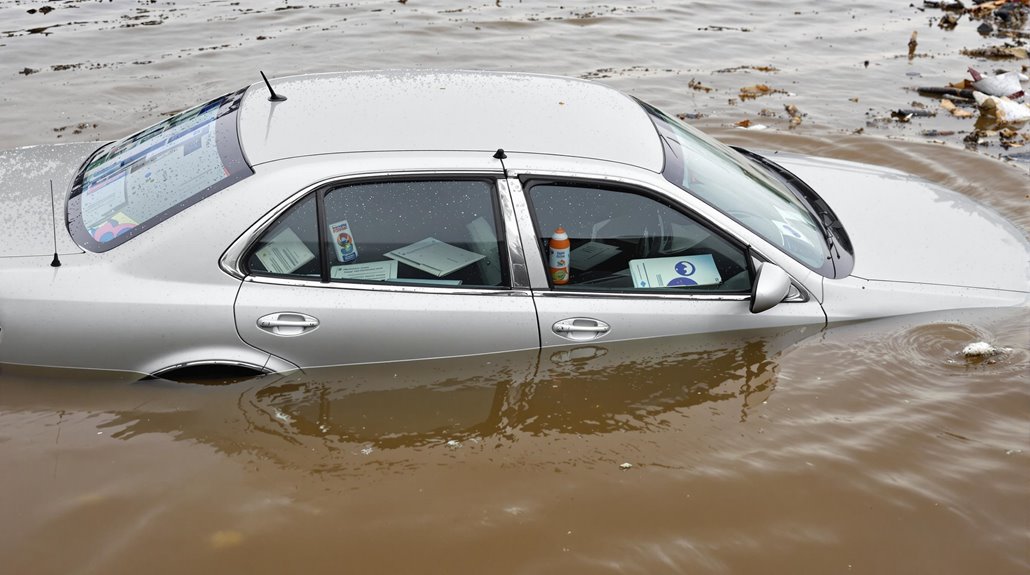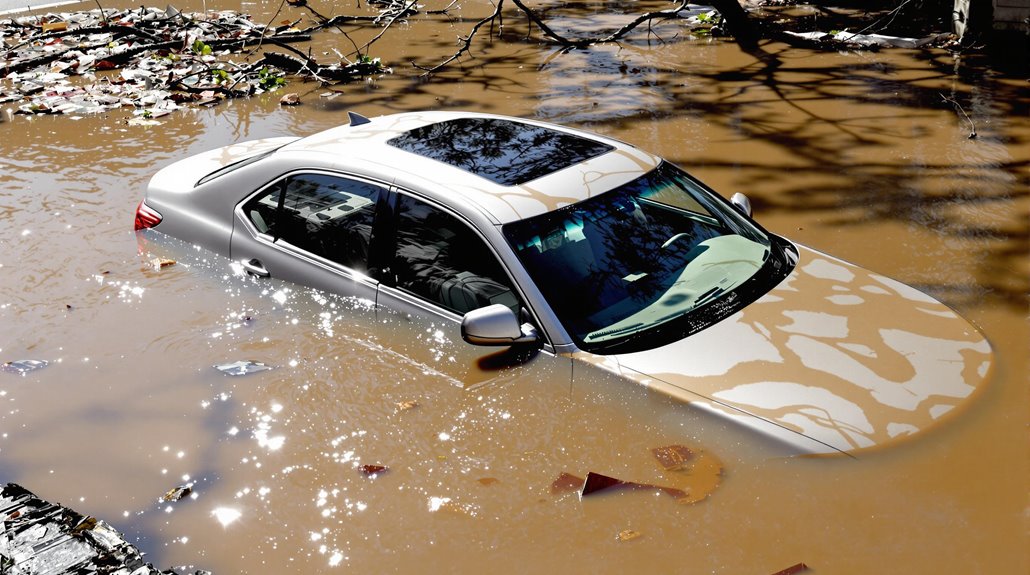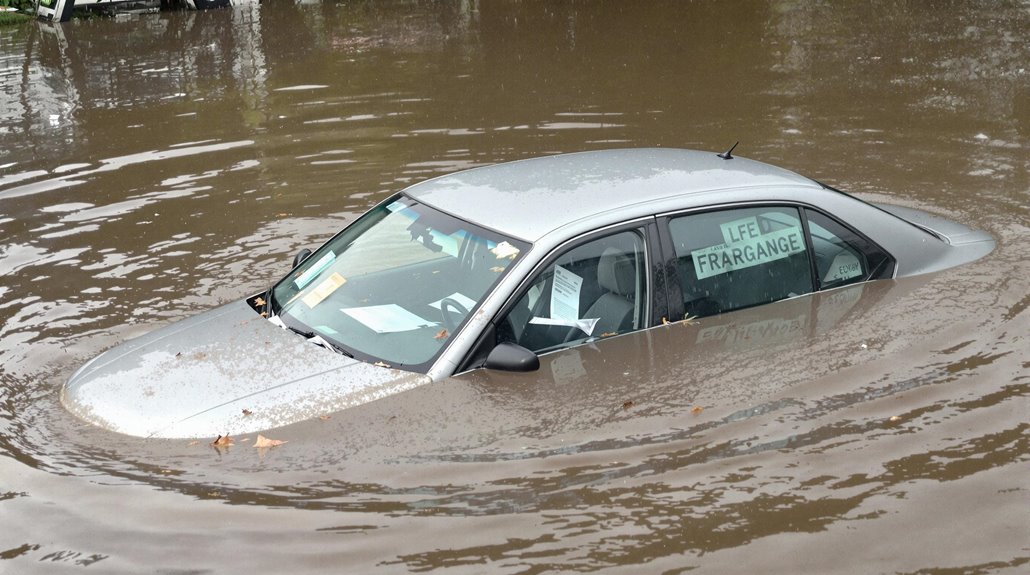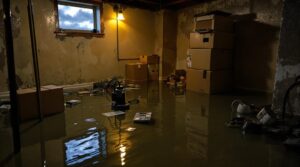Car insurance policies that include extensive coverage typically cover flood damage to vehicles, providing financial protection against the cost of repairs or replacement resulting from water-related incidents. This coverage addresses damage from heavy rains, hailstorms, and driving through flooded areas. Extensive coverage is vital for vehicle owners in flood-prone areas. The extent of coverage varies by policy, and understanding the specifics of a policy's flood damage coverage is important for vehicle owners seeking protection against unforeseen flood damage.
Key Takeaways
- Comprehensive coverage typically includes protection against flood damage to vehicles, covering repairs or replacement costs minus the deductible.
- Flood damage coverage addresses damage from heavy rains, hailstorms, and driving through flooded areas, including rust and mold issues.
- To file a flood damage claim, vehicle owners must have comprehensive coverage and provide documentation of the damage.
- Coverage limits for flood damage are usually based on the actual cash value of the vehicle, and compensation may not exceed this amount.
- Liability-only policies do not cover flood damage, and certain types of water damage may be excluded unless specified in the policy.
Does Comprehensive Coverage Include Flood Damage?
How does extensive coverage respond to the threat of flood damage? All-encompassing coverage, typically included in a car insurance policy, provides protection against flood damage, covering repairs or replacement costs minus the deductible. This type of insurance coverage addresses damage to your vehicle resulting from various types of water damage, including flooding from heavy rains or hailstorms, as well as damage from driving through flooded areas. In the event of flood damage, policyholders can file an insurance claim under all-encompassing coverage to repair or replace their vehicle. Adding comprehensive coverage to an auto insurance policy can greatly enhance protection against flood-related incidents, especially in flood-prone areas. This coverage is essential for vehicle owners who want to guarantee they are protected against unforeseen flood damage.
What Types of Flood Damage Are Covered by Car Insurance?
Thorough car insurance coverage encompasses various types of flood damage, including damage caused by submersion, heavy rains, or other water-related incidents. This coverage also extends to damage resulting from driving through flooded areas, which can lead to cosmetic issues and compromise critical vehicle components. Policyholders should review their thorough coverage limits to understand the extent of their protection against flood damage.
Types of Flood Damage
Flood damage to vehicles can manifest in various forms, ranging from cosmetic issues to significant mechanical problems. Extensive car insurance typically includes damages from flooding, heavy rains, hailstorms, and other weather-related incidents. To better understand the types of flood damage covered by car insurance, consider the following examples:
- Damage from driving through flooded areas, including rust, fogged lights, and mold growth in the interior
- Significant damage to the engine, electrical system, and transmission due to flooding
- Cosmetic issues such as water spots, peeling paint, and torn upholstery
- Corrosion and rust damage to the vehicle's undercarriage and other metal components
It's essential to review insurance policy terms to determine the extent of coverage for damage caused by flooding and to understand how extensive car insurance can help cover the cost of repairs or replacement.
Flood Damage Coverage Limits
When it comes to addressing the cost of repairs or replacement of a vehicle damaged by flooding, understanding the coverage limits of an auto insurance policy is vital. Thorough coverage is necessary for car insurance to cover flood damage, as liability-only policies do not provide this protection. The coverage limits for flood damage are typically based on the actual cash value of the vehicle. To qualify for a covered claim, vehicle owners must document the damage and file a claim promptly. In the event of extensive flood damage, the vehicle may be declared a total loss. It is important for vehicle owners to review their auto policy to understand the scope of coverage and the process to file a claim for damage to their car.
How to File an Insurance Claim for a Flooded Car

Filing an insurance claim for a flooded car requires the vehicle owner to have extensive coverage, which specifically addresses flood damage. To initiate the claims process, the policyholder must contact their insurance agent as soon as possible, providing documentation of the damage. Determining coverage limits, understanding required documentation, and preparedness for out-of-pocket deductible costs are critical components of a successful claims submission.
Filing Insurance Claims
In the aftermath of a vehicle being submerged in water, obtaining broad coverage is essential to recover losses, as it is the sole type of auto insurance that offers protection for flood damage. All-inclusive coverage is the only type of auto insurance that covers flood damage. To file a claim, it is vital to document the damage with photos or videos, which will serve as evidence when submitting the claim to the insurance company.
- Take clear photos of the vehicle's exterior and interior to showcase the extent of the damage
- Capture videos of the vehicle's mechanical and electrical systems to demonstrate any malfunctions
- Avoid starting the vehicle to prevent further damage
- Contact your insurance agent for guidance on the claims process and be prepared to pay your deductible before the insurance payout is processed.
Determining Coverage Limits
How much compensation can be expected from an insurance claim for a flooded car? The amount varies depending on the insurance policies and the extent of the damage. Extensive Coverage is designed to cover the cost of repairing or replacing a damaged or totaled vehicle due to flood. Insurance companies offer varying levels of coverage, and policyholders need to review their terms and conditions to understand the limits of their coverage. Typically, policyholders can expect to receive compensation for the vehicle's actual cash value minus the deductible. In cases where the vehicle is deemed a total loss, the insurance company will typically cover the vehicle's actual cash value rather than the cost of repairs. Reviewing the policy will help you understand the limits of the car insurance cover flood.
Is Flood Damage to Your Car Repairable?
To what extent is flood damage to a vehicle repairable? The answer largely depends on the severity of the damage. In cases where the engine or electrical systems are severely compromised due to submersion in floodwater, the vehicle may be declared a total loss by the insurer, as the cost of repairs exceeds the vehicle's value.
The following highlights potential issues with flood-damaged vehicles:
- Interior mold growth can spread rapidly if not addressed promptly
- Rust can develop in mechanical components, causing long-term problems
- Minor cosmetic issues may be easily repairable under extensive insurance
- Significant water damage can render a vehicle uneconomical to repair, necessitating an insurance claim to cover the loss. Extensive insurance typically covers repair costs, minus a deductible that the owner must pay.
What Is Not Covered by Car Insurance in the Event of a Flood?

Although extensive coverage typically offers protection for vehicles damaged in a flood, significant limitations and exclusions apply. Car insurance policies with only liability coverage do not cover flood damage, leaving owners responsible for repair costs. Additionally, damages resulting from negligence, such as leaving windows open during a storm, are typically not covered by auto insurance. Owner-installed electronic components are also generally excluded from water damage coverage under thorough coverage. Moreover, thorough coverage may exclude certain types of water damage, such as damage from standing water or deep puddles, unless explicitly included in the policy terms. A flood insurance policy will not cover flood damage to vehicles, as motor vehicles are specifically excluded from such policies, requiring vehicle owners to address flood damage through their auto insurance.
Additional Insurance Options for Flood Protection
The limitations and exclusions in standard car insurance policies highlight the need for vehicle owners to contemplate additional protection options against flood damage. Extensive coverage and other additional coverages can provide enhanced protection against flood damage. These options may include:
- Gap insurance to cover the difference between the vehicle's actual cash value and the amount owed on a loan if the car is totaled
- Rental Car Reimbursement Coverage to assist with transportation costs while the vehicle is being repaired after flood-related damage
- Additional coverages specifically for natural disasters to enhance protection against flood damage
- Emergency roadside assistance or mechanical breakdown coverage for further support in the event of flood-related issues
Reviewing and upgrading an insurance policy to include extensive coverage can help vehicle owners better prepare for weather events and potential flood damage.
How to Protect Your Car From Flood Damage

Numerous proactive measures can be taken by vehicle owners to safeguard their cars against flood damage. Parking in elevated areas or garages during severe weather warnings can minimize exposure to rising water levels. Regular vehicle maintenance is also essential to guarantee seals and drains function correctly, preventing water from entering the interior during heavy rains. Utilizing protective covers specifically designed for vehicles can provide an additional layer of defense against water damage when parked outside. Staying informed about local flood zones and weather forecasts using weather apps can also aid in making proactive decisions about parking and vehicle safety. By taking these steps, owners can protect their vehicles and potentially avoid the need to file a claim for a flooded car, even with extensive coverage on their auto.
Understanding Your Policy's Flood Damage Coverage Limits
When purchasing an auto insurance policy, vehicle owners need to be aware of the flood damage coverage limits included in their extensive coverage. This type of coverage is essential to protect against flood damage, as it specifically covers losses from flooding, heavy rains, and hailstorms.
The following key points should be considered when reviewing policy limits:
- Extensive coverage typically includes a deductible, which must be paid out-of-pocket before insurance coverage kicks in for repairs.
- The maximum payout for flood damage claims is usually based on the actual cash value of the vehicle.
- Policy limits may define how much the insurer will pay in the event of a flood-related total loss.
- Liability insurance does not include protection for flood damage to your vehicle, making extensive coverage a must to protect your car.








